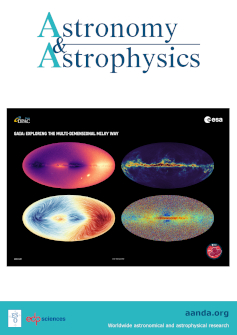恒星合并的质量分布
IF 5.4
2区 物理与天体物理
Q1 ASTRONOMY & ASTROPHYSICS
引用次数: 0
摘要
背景FS CMa恒星属于表现出B[e]现象的恒星中的一类,其主要表现为光谱中存在禁止发射线和强烈的红外(IR)过量。目前已知的 FS CMa 星只有几十颗,它们的性质还不清楚。最近,在 FS CMa 星 IRAS 17449+2320 中发现了一个强磁场。强磁场的强度加上银河系北极方向上异常高的空间速度表明该天体具有合并后的性质。这种恒星合并可以解释一些FS CMa恒星的复杂和有时混乱的行为。 目的:为了找出B型恒星合并是否可以被探测到,我们使用Aarseth的NBODY6代码进行了数值模拟统计研究。我们显示了中低质量恒星(从≈1.4到≈8 M⊙),尤其是B型恒星合并的重要性。我们分析了两组具有不同初始轨道周期分布的N-体模拟。在模拟中,质量较大的双星与质量较小的双星的处理方法不同,通常使用的质量极限是5 M⊙。除此以外,我们还使用了 2 M⊙的值来测试这一模糊极限对结果的影响。通过观察质量、与诞生星团的距离以及速度分布,我们研究了单个光谱类型在合并动力学方面的统计意义,以及合并事件如何影响恒星演化。我们发现,在参与合并形成的模拟疏散星团中,大约 50%的恒星是 B 型恒星。因此,超过50%的合并产物最终也是B型恒星。另外,在所有 B 型恒星中,有 12.54% 到 23.24% 是合并的。这些结果是初始质量函数、双星参数的初始分布以及B型恒星质量范围大的自然结果。不可忽略的一部分合并发生在进入共同包层阶段之前,我们在河外星系距离上探测到了合并事件。检测到的合并总量可能会对星系的化学演化产生影响。合并产物的质量分布显示出 A 型恒星的峰值,这与观测到的大质量 Ap 星一致。晚期B型FS CMa恒星的合并后产物可能是质量非常大的磁性Ap恒星的祖先。我们的研究结果也有助于解释一些磁性白矮星的性质。我们将模拟合并的 W 分量和空间速度与观测到的 FS CMa 星样本进行了比较。本文章由计算机程序翻译,如有差异,请以英文原文为准。
The mass distribution of stellar mergers
Context. FS CMa stars belong to a diverse group of stars exhibiting the B[e] phenomenon, which manifests itself mainly by the presence of forbidden emission lines and a strong infrared (IR) excess in their spectra. Only a few tens of FS CMa stars are known and their nature is still unclear. Recently, a strong magnetic field has been discovered in the FS CMa star IRAS 17449+2320. Its strength combined with an unusually high space velocity in the direction of the Galactic north pole point to the object having a post-merger nature. Such stellar mergers may provide an explanation for the complex and sometimes chaotic behaviour of some of the FS CMa stars.Aims. In order to find out whether B-type stellar mergers are detectable, we did a statistical study of numerical simulations using Aarseth’s NBODY6 code. We show the importance of stellar mergers of low- to intermediate-mass stars (from ≈1.4 to ≈8 M⊙) and for B-type stars in particular.Methods. We analysed two sets of N-body simulations with different initial orbital period distributions. In the simulations, more massive binaries are treated differently than less massive binaries and the mass limit usually used is 5 M⊙. In addition to this, we also used the value of 2 M⊙ to test the influence of this ambiguous limit on the results. Looking at mass, distance from their birth cluster, and velocity distributions, we investigated the statistical significance of individual spectral types in terms of merger dynamics and how merger events affect the stellar evolution.Results. We have found that around 50% of stars in the simulated open clusters involved in the formation of mergers are B-type stars. As a result, more than 50% of the merger products end up as a B-type star as well. Also, between 12.54% and 23.24% of all B-type stars are mergers. These results are a natural consequence of the initial mass function, initial distribution of the binary star parameters, and large range of masses for B-type stars. A non-negligible fraction of mergers occurred before entering the common envelope phase and we detected merger events at extragalactic distances. The total amount of detected mergers could have an impact on the chemical evolution of galaxies. The resulting mass distribution of merger products shows a peak for A-type stars, which is in agreement with observed massive Ap stars. Post-mergers among late B-type FS CMa stars could be the progenitors of very massive magnetic Ap stars. our results could also help to explain the nature of some magnetic white dwarfs. We present a comparison of the W component and the space velocity of the simulated mergers with a sample of observed FS CMa stars.
求助全文
通过发布文献求助,成功后即可免费获取论文全文。
去求助
来源期刊

Astronomy & Astrophysics
地学天文-天文与天体物理
CiteScore
10.20
自引率
27.70%
发文量
2105
审稿时长
1-2 weeks
期刊介绍:
Astronomy & Astrophysics is an international Journal that publishes papers on all aspects of astronomy and astrophysics (theoretical, observational, and instrumental) independently of the techniques used to obtain the results.
 求助内容:
求助内容: 应助结果提醒方式:
应助结果提醒方式:


